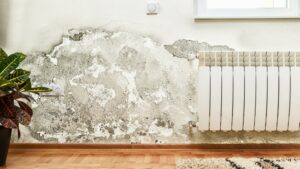Joe Lange, a Green Home Solutions franchisee in Charleston, South Carolina, discusses how to eliminate the mold and poor air quality issues often brought on by excessive rainfall.
With record rainfall being recorded all across the U.S. in 2019, the dangers posed by mold and poor indoor air quality borne from these moist conditions are more prominent than ever before. Yet, when these storms hit, their negative effects often linger long after the rainwater itself has been dealt with.
Water damage that occurs as a result of excessive rainfall has harmful effects that lie below the surface; namely, in the form of mold that can cause dire health effects through long-term exposure. Few contractors are equipped to identify and eliminate it once and for all.
Joe Lange, a Green Home Solutions franchisee in Charleston, South Carolina, knows this better than most. A longtime Atlanta resident, Lange first came across Green Home Solutions as a customer, when he was working on a project in which he encountered mold. Lange reached out to Green Home Solutions, as he knew the brand helps homeowners and businesses eradicate harmful mold through the application of proven, EPA-registered products, proven to ensure safety and efficacy, resulting in improved indoor air quality. Lange later went into business with the brand after several massive storms came through the Southeast beginning in the Fall of 2015, piquing his interest in providing such a necessary service to one of the many areas of the country increasingly affected by excessive rainfall.
“In Charleston specifically, many of the city’s residences are in flood zones, and excessive rainfall is something we deal with quite a bit,” Lange said. “It’s not necessarily the day the storm comes that we’re needed, as we typically see a delay of a week up to several months between the worst of it and when we start getting calls because it takes time for some molds to develop to the point where it can be detected by sight or smell.”
Because of such a delayed time until discovery, household mold can take a dangerous toll on the health of a residence’s occupants. There’s more to remediation than just cutting out the affected areas, too. Mold growth is a symptom of moisture intrusion. Identifying, correcting and managing the source of moisture is critical to successful remediation. Green Home Solutions’ protocols and procedures are the most effective way to return the area to a healthy household environment.
With a history of helping the communities in which it operates to recover from the damaging effects of these storms, Green Home Solutions leverages unparalleled expertise to provide customers with peace of mind in a time of great need. The brand provides more than just physical assistance, too—according to Lange, education is a key part of the impact the business has on communities.
“Major storms and flooding affect the lives of many. Many clients don’t fully understand the dangers mold poses until it affects them directly, so we’re heavily involved with the health vertical to spread the word,” Lange said. “We try to focus on is informing people of the dangers untreated mold poses to them and how we may be able to help. It’s critical to attack the mold at its source, or it will return. We hunt for the cause, eliminate it and educate clients on how to detect potential problems in the future.”
Fortunately, Green Home Solutions’ services include indoor air quality inspections, allowing the brand to expertly pick up on any issues that may not yet be visually presenting themselves. And if you do see visible mold, Lange warns, “Don’t use bleach!”
“Using bleach on mold is like shaving—it may remove surface growth, but it does not get to the roots behind it,” he said. “Bleach is 99% water, so cleaning with it adds moisture to the source and allows it to keep growing.”
Some of Lange’s other key tips for homeowners who have experienced flooding include monitoring the indoor humidity level and maintaining their HVAC systems.
“Most traditional thermostats focus on temperature, but humidity is a much better gauge to help maintain healthy indoor air quality,” he said. “The most important thing you can do is eliminate any leaks right away and make sure to keep your home below 50% relative humidity. We often find that HVAC systems are oversized—and if a system is too big, it will run, satisfy the thermostat and turn off, which means it isn’t dehumidifying. If you have warm and cold air mixing in a crawl space, the condensation makes your home susceptible to mold growth, which can quickly compromise the air in your home.”
Because the company’s services are in such high-demand after severe weather events, Green Home Solutions Chief Development Officer Glen Snyder said the brand is actively seeking new franchise owners in markets that are hit most frequently. Start-up costs for a Green Home Solutions franchise range from $50,475 to $132,000, including a $20,000 franchise fee. For more information on available territories, visit https://greenhomesolutionsfranchising.com.
